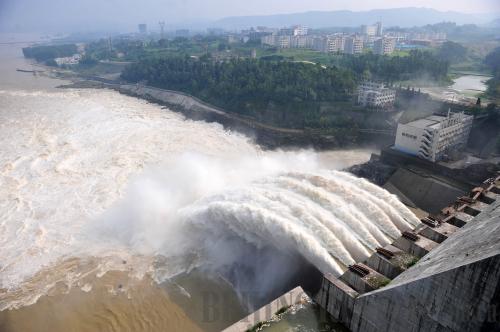|
 |
|
HEADWATER: Water is released from sluice gates of the Danjiangkou Reservoir on July 27, 2010. The reservoir diverts water all the way to Beijing and Tianjin (HAO TONGQIAN) |
Thinking big seems to be a Chinese tradition. Ancient legends often feature figures that can audaciously move mountains, change courses of rivers, fly to the Moon and dive deep into the oceans, while Chinese ancestors are remembered for building the Great Wall and digging the Grand Canal, respectively the longest of their kind in the world.
New wonders continue to be engineered in the country today, and the South-to-North Water Diversion Project is one of them.
Proposed by late leader Mao Zedong in 1952, the project aims to transfer water resources from the south to the comparatively drought-prone north along three routes—eastern, central and western. It is the largest water transfer project in the world.
Construction of the eastern route started in 2002, and that of the central route started in 2003, whereas the western route is still in a planning stage.
The eastern route is expected to be completed in March and in service in the third quarter of this year, said the Office of the South-to-North Water Diversion Project Commission of the State Council. The central route is slated for completion by the end of 2013, and will supply water in 2014.
Water to the eastern route will be pumped from the section of the Yangtze River near Yangzhou City in Jiangsu Province, and delivered mainly through the Grand Canal across Jiangsu, Shandong and Hebei provinces to major cities along the line.
The central route will draw water from the Danjiangkou Reservoir on the Hanjiang River, a tributary of the Yangtze River, China's longest waterway, and will eventually bring water to Beijing and Tianjin.
The artery of the eastern and central routes will total 2,899 km in length. In addition, the six provinces and municipalities along the two routes will build tributary canals with a total length of 2,700 km, according to Xinhua News Agency.
Water will be fetched uphill by a series of pump stations along the lines before reaching the Yellow River, the country's second longest waterway. After passing the Yellow River through tunnels beneath the riverbed, water can flow naturally to its destinations.
Water supplies
The North China Plain, with megacities such as Beijing and Tianjin, is home to one fifth of China's 1.3-billion population and arable land.
As cities sprawl in north China, water consumption is soaring, yet the climate has become drier. "Over the past two decades, precipitation in north China has decreased by 10-15 percent," said Shi Jiansheng, Director of the Institute of Hydrogeology and Environmental Geology under the Chinese Academy of Geological Sciences.
Natural rainfall on the northern plains cannot meet demand for water. In the past few decades, groundwater resources have been exploited to make up for the shortfall, which leads to vast geological subsidence and disappearance of some rivers, lakes and springs in affected areas.
Water transferred from the south will mainly be used to quench the thirst of northern cities along the routes, because "cities' social and economic development is severely restricted by water shortage, and urban enterprises and residents are more able to pay for transferred water," according to the Office of the South-to-North Water Diversion Project Commission of the State Council.
In the meantime, by supplying water to cities, the project is expected to alleviate the burden on local aquifers and free up water for agricultural use.
Beijing has suffered from water shortage since 1999. In 2008, the section of the central route from Shijiazhuang City in Hebei Province to Beijing was completed. Since then, water has been drawn from reservoirs in Hebei four times to meet emergency water needs in Beijing.
After the entire central route is put in service in 2014, 1 billion cubic meters of water will be brought into Beijing each year, accounting for one fourth of the capital's total water supply, said Zhang Tong, Vice President of the Beijing Water Institute, at a meeting to promote the capital's ecological progress last December.
According to Xinhua, the project is expected to divert 44.8 billion cubic meters of water annually from the Yangtze River to the north. While diverted water is expected to enhance the ecological environment of the north, critics worry that the project is "robbing Peter to pay Paul," warning it will cause water shortages and other environmental problems in the south.
In response, the Ministry of Water Resources said that the project will only draw out 1 percent of the total runoff volume of the Yangtze River, hence avoiding any significant impact on water resources along the river; nonetheless, the project will transfer out about 20 percent of the total runoff volume of the Hanjiang River. If no remedial measures are taken, the water loss will affect navigation and industrial and agricultural development in the middle and lower reaches of the Hanjiang River.
Pollution control
In addition to geographical obstacles, another difficulty that the project has to overcome is pollution in water bodies along the project's routes, which experts said is the most-difficult-to-control water pollution in the world.
| 